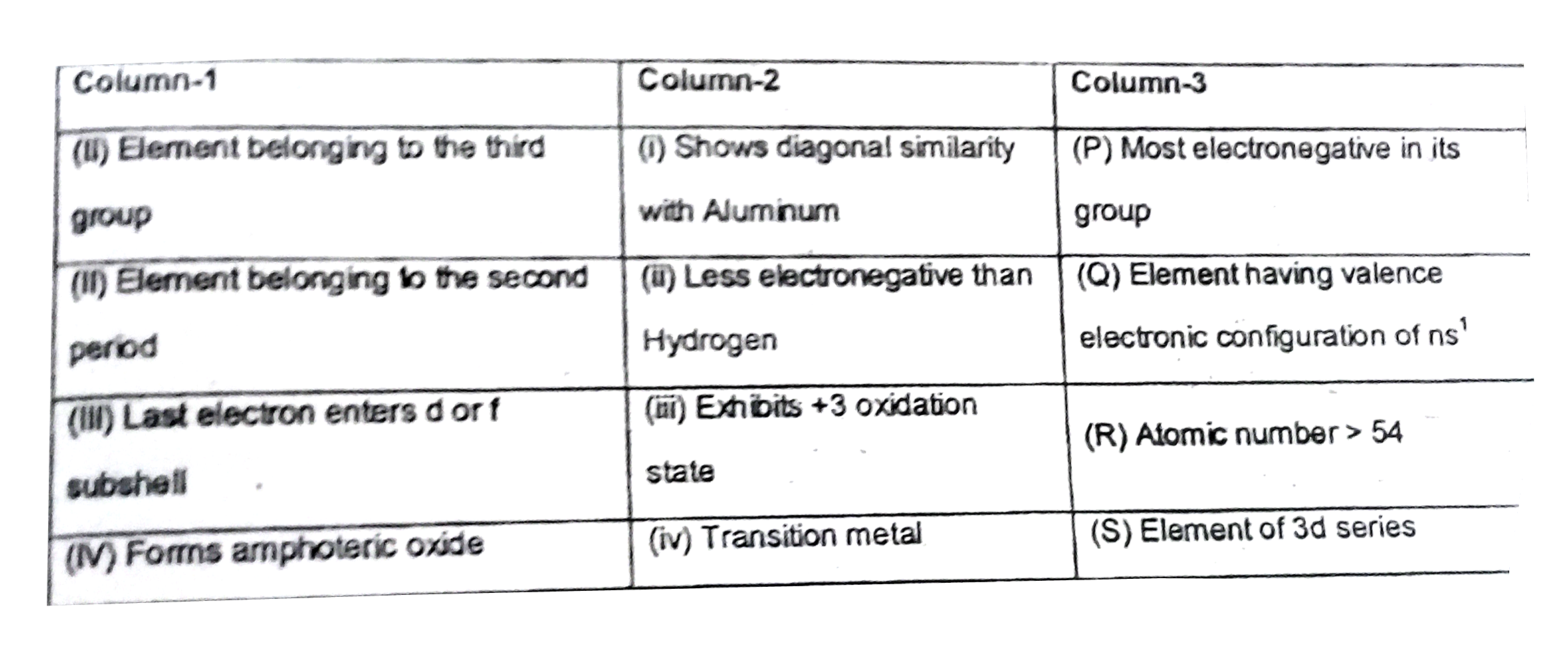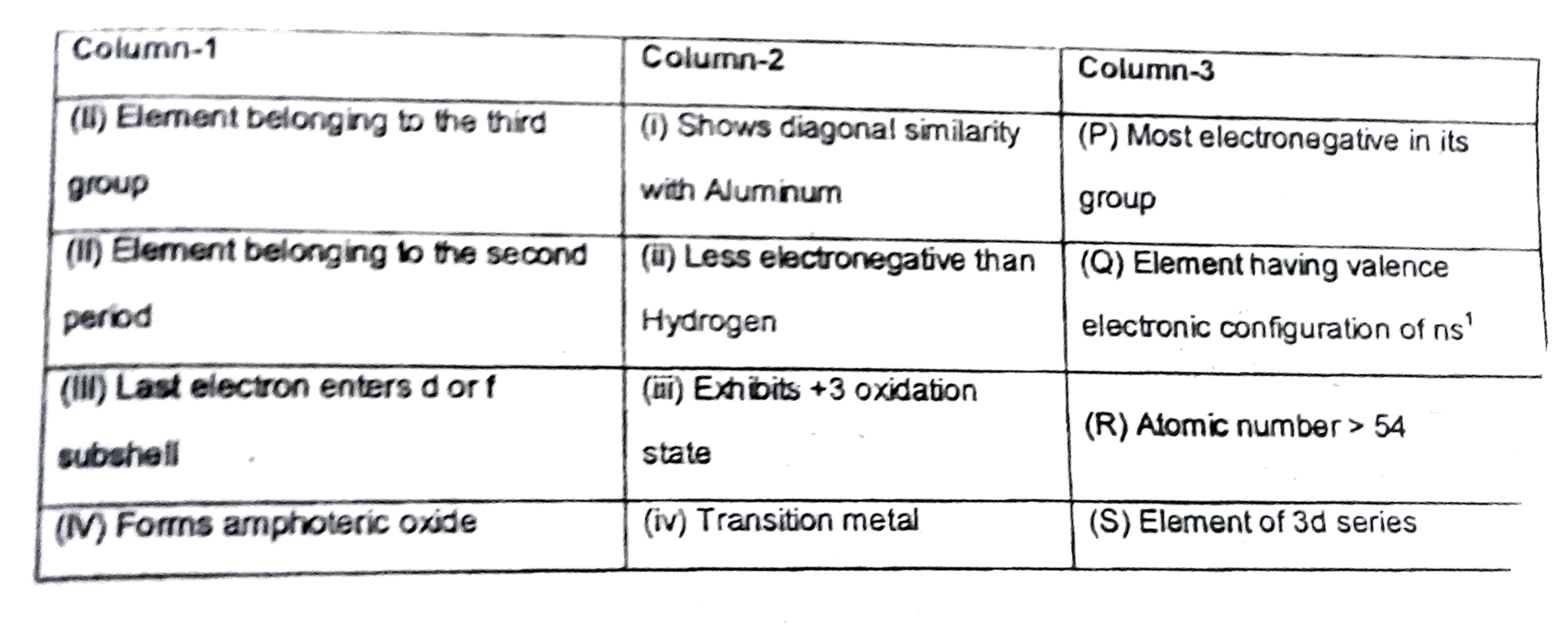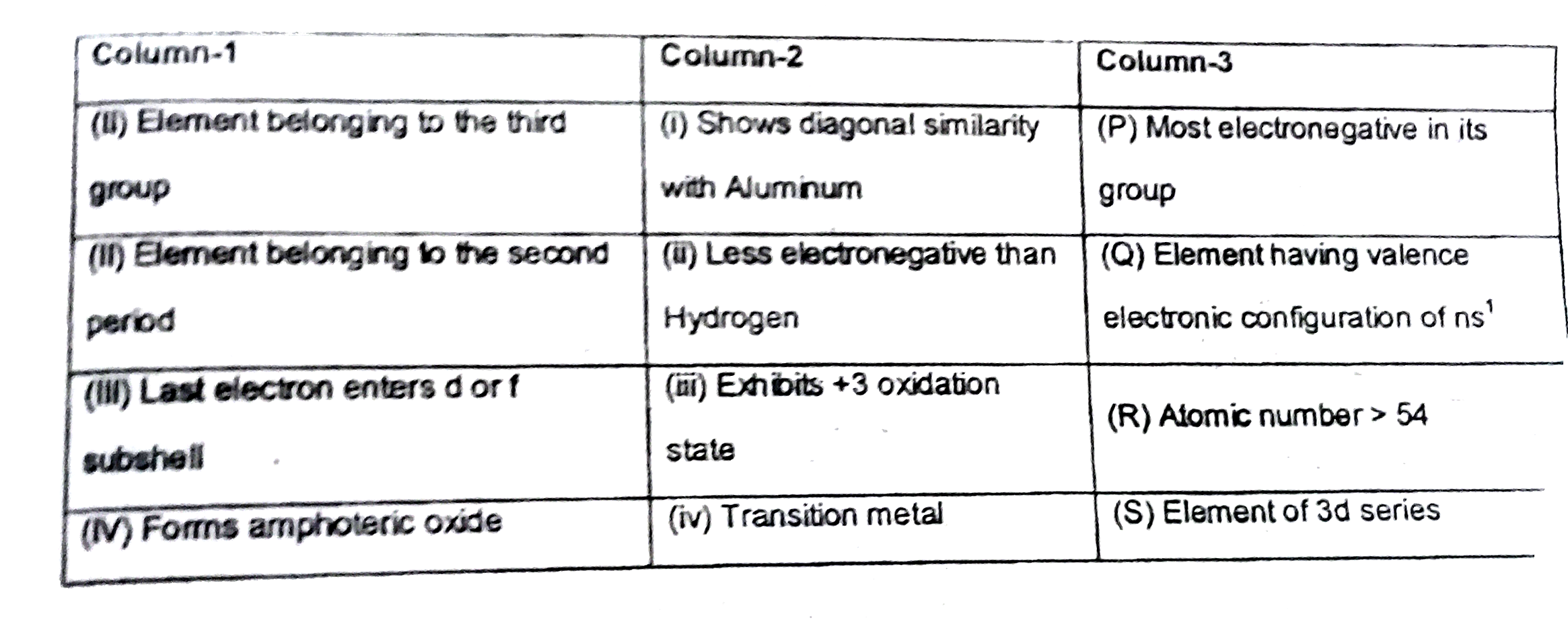Modern peroidic table helps classify elements according to their similarities.Consider the columns mentioning certain details about elements with comments on their important features.
Answer the question that follow :

The appropriate combination for Lanthanum is :
(I)(ii)(S)
(IV)(iii)(S)
(III)(iii)(R)
(IV)(iv)(Q)
The correct Answer is:C
La belongs to 3rd group has atomic no > group has atomic no >54
last e− enters d,f subshall.
Topper's Solved these Questions
Similar Questions

The table shows a part of the periodic table, with some elements in their position. Answer the following questions:
How many atoms of element 8 will combine with one atom of element number 14 ?View SolutionConsider the elements of period 2 in the modern periodic table. Answer the following questions with explanation.
Which is the most electropositive element in this period?View Solution
Knowledge Check
- Question 1 - Select One
Modern peroidic table helps classify elements according to their similarities.Consider the columns mentioning certain details about elements with comments on their important features.
Answer the question that follow :

Which of the following combinations is appropriate for Beryllium ?A(IV)(i)(P)B(II)(i)(Q)C(III)(ii)(P)D(IV)(iii)(R) - Question 2 - Select One
Modern peroidic table helps classify elements according to their similarities.Consider the columns mentioning certain details about elements with comments on their important features.
Answer the question that follow :

Which of the following combinations is correct for Chromium but not for Zinc ?A(II)(ii)(Q)B(III)(iv)(S)C(IV)(iii)(R)D(IV)(ii)(P) - Question 3 - Select One
Although every element is different from every other element, yet some elements have certain similarities. Based upon these similarities, the scientists after numerous attempts were are given. Based upon these multiple choice questions are ultimately sucessful in arranging the various elements into groups or chemical families in such a way that similar elements were put together. This arrangement of elements is called classification of elements and this led to the formulation of a periodic table. The periodic table is the most organising principle in chemistry. If you know the properties of any element in a group, or of the columns, of the periodic table, you can make a good guess at the properties of every other element in the same group and even the elements in the neighbouring groups. The first break through in the classification of elements, was provided by Russian chemist Dmitri lunovich Mendeleev. Taking the chemistry of the elements as his primary organising principle, he arranged the known elements by atomic mass and grouped them together according to their chemical reactivity He also observed that there occurred recurrence of elements with similar physical and chemical properties after certain regular intervals. On the basis of these similarities Mendeleev proposed his periodic law which states that physical and chemical properties of elements are a periodic function of their atomic masses Moseley suggested that atomic number was a better fundamental property of an element than its atomic mass. This forms the basis of the Modern periodic law. Thus, modern periodic law states that physical and chemical properties of the elements are a periodic function of their atomic numbers. In the modern long form of periodic table the elements are arranged in the increasing order their atomic numbers and the elements with similar properties repeat after regular intervals. Repetition of chemical properties of elements at regular intervals when arranged in a definite order is called periodicity of properties. This is due the recurrence of similar outer electronic configuration at certain regular intervals. The long form of periodic table may be divided into four main blocks known as s, p, d and f blocks depending upon the type of orbitals being filled up with the increase in atomic number in atoms of the elements. The nature of the block to which an element belongs depends upon the type of subshell which receives the last electron.
Long form of periodic table is based on the properties of the elements as a function of theirAatomic massBatomic sizeCatomic numberDnone of the above three.
Consider the elements of period 2 in the modern periodic table. Answer the following questions with explanation.
Name the element which has same number of electrons in the first and second shell.View SolutionIn the modern periodic table, the elements are arranged in the increasing order of their atomic number. This arrangement is based on the modern periodic law, which states that the properties of elements are a periodic function of their atomic numbers. In the modern periodic table, each column is called a group and each row is called a period. Elements within the same group show similarity and gradation in properties. This is due to the same number of electroms in the outermost shell .
Based on the above paragraph, answer the following question:
State the law on which modern periodic table is based.View SolutionIn the modern periodic table, the elements are arranged in the increasing order of their atomic number. This arrangement is based on the modern periodic law, which states that the properties of elements are a periodic function of their atomic numbers. In the modern periodic table, each column is called a group and each row is called a period. Elements within the same group show similarity and gradation in properties. This is due to the same number of electroms in the outermost shell .
Based on the above paragraph, answer the following question:
How many groups are there in the modern periodic table?View SolutionIn the modern periodic table, the elements are arranged in the increasing order of their atomic number. This arrangement is based on the modern periodic law, which states that the properties of elements are a periodic function of their atomic numbers. In the modern periodic table, each column is called a group and each row is called a period. Elements within the same group show similarity and gradation in properties. This is due to the same number of electroms in the outermost shell .
Based on the above paragraph, answer the following question:
What is the number of valence electrons in an element of group 1 and group 18 respectively?View SolutionAlthough every element is different from every other element, yet some elements have certain similarities. Based upon these similarities, the scientists after numerous attempts were are given. Based upon these multiple choice questions are ultimately sucessful in arranging the various elements into groups or chemical families in such a way that similar elements were put together. This arrangement of elements is called classification of elements and this led to the formulation of a periodic table. The periodic table is the most organising principle in chemistry. If you know the properties of any element in a group, or of the columns, of the periodic table, you can make a good guess at the properties of every other element in the same group and even the elements in the neighbouring groups. The first break through in the classification of elements, was provided by Russian chemist Dmitri lunovich Mendeleev. Taking the chemistry of the elements as his primary organising principle, he arranged the known elements by atomic mass and grouped them together according to their chemical reactivity He also observed that there occurred recurrence of elements with similar physical and chemical properties after certain regular intervals. On the basis of these similarities Mendeleev proposed his periodic law which states that physical and chemical properties of elements are a periodic function of their atomic masses Moseley suggested that atomic number was a better fundamental property of an element than its atomic mass. This forms the basis of the Modern periodic law. Thus, modern periodic law states that physical and chemical properties of the elements are a periodic function of their atomic numbers. In the modern long form of periodic table the elements are arranged in the increasing order their atomic numbers and the elements with similar properties repeat after regular intervals. Repetition of chemical properties of elements at regular intervals when arranged in a definite order is called periodicity of properties. This is due the recurrence of similar outer electronic configuration at certain regular intervals. The long form of periodic table may be divided into four main blocks known as s, p, d and f blocks depending upon the type of orbitals being filled up with the increase in atomic number in atoms of the elements. The nature of the block to which an element belongs depends upon the type of subshell which receives the last electron.
In the long form of periodic table, all the non-metals are collectively placed inView Solution

